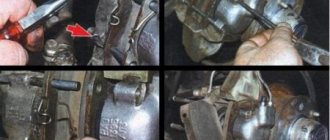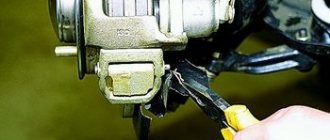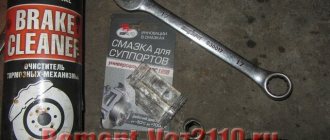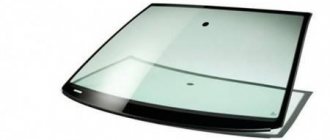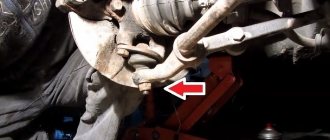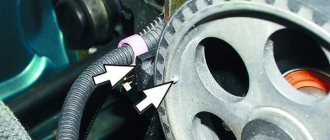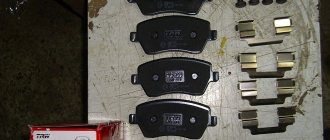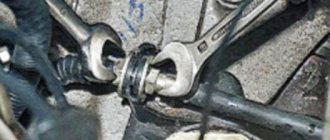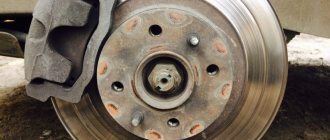Main features
There are several symptoms by which you can determine the wear of these elements:
- Increased brake pedal travel. It becomes softer and only grips at the end. This reduces the braking efficiency of the vehicle. This significantly affects traffic safety. Similar symptoms can occur with brake fluid leaks. But if its level is in order, and there are no drips on the tubes and connections, then the rear brake pads on the VAZ-2110 need to be replaced.
- Increased travel of the parking brake lever. If the pedal can be soft even if the front pads are worn out, then a weak handbrake indicates wear on the rear ones. How to determine whether the lever stroke in a car is normal? To do this, place the car on an inclined surface (at least ten degrees) and tighten the handbrake. If the car rolls down, it means the cable is loose or the rear pads are worn out. You can also count the number of clicks on the lever. In normal condition there should be 3-4. If there are 5 or more of them, then you need to replace the rear brake pads on a VAZ-2110.
- Characteristic creaking noise when braking. Subsequently, it can develop into vibration. In this case, the friction material is completely worn out, and the lining is in contact with the drum mechanism with bare metal. Driving with such a symptom is extremely dangerous. At one point, the pads can simply jam, not to mention the crazy wear caused by metal-to-metal friction.
- Minimum thickness of friction material. Unlike previous cases, this can only be found out by removing the drum cover. Experts note that the thickness of the friction material on the rear drum mechanisms of the “tens” should be at least one and a half millimeters.
How to replace the rear ones
Replacing rear pads on VAZ-2110 series cars and their derivatives is somewhat more difficult, since they are of the drum type. Replacement work is carried out as follows:
- The rear of the car is jacked up, after which the wheel is removed.
- The guide pins located on the drum are unscrewed (if the pins become soured, it is possible to remove the drum along with the hub after unscrewing it).
The work is carried out with a 12 key - If the drum cannot be dismantled, tap it.
It is better to tap through a wooden spacerOr using a mounting blade
- Using long-nose pliers, remove the cotter pin located on the left side.
- Using pliers, disconnect the spring that tightens the brake pads at the bottom.
We pry up the spring... and take it out
- The fastening side springs are removed (steps 1–4), the spacer bar (5), after which the pads are removed from the drum body (6 and 7). Step 7 Step 6 Step 5 Step 4 Step 3 Step 2 Step 1
- Installation of the pads is carried out in reverse order.
Video: How to remove and install rear brake pads on a ten
Let's get started
So, how do you replace the rear brake pads on a VAZ-2110 with your own hands? First we need to place the car on a flat and hard surface. The presence of a hole is not necessary.
We remove the car from the handbrake and put it in gear. For greater stability, we install anti-roll bars in front. Then we remove the wheel bolts from the rear and lift the wheel. Next, we take it completely out and start working with the drum. We need to unscrew its guide pins. Please note that they may be difficult to remove. Use liquid key lubricant. As a last resort, unscrew the rear hub nut using a 30mm wrench with a long lever (on a dressed wheel). Next, take out the drum cover and, using long-nose pliers, remove the cotter pin from the left side. Using pliers, disconnect the lower spring that tightens the pads.
How do you then replace the rear brake pads on a VAZ-2110? After that, we move on to the springs located on the sides. They hold the brake pads for greater stability. We also remove them out using pliers. At the next stage, we push the lining from above. To do this you need to make every effort. When the pads are stretched, the plate will fall down. Next, the pads can be safely removed out.
Tool
For work, it is most convenient to use a lift or inspection hole, since some operations must be (or more convenient) performed from under the machine.
For our work we will need the following set of tools:
- plumber's hammer;
- rubber straightening hammer or wooden spacer;
- steel rod with a hook at the end for removing and installing springs;
- mount;
- standard set of tools and penetrating lubricant.
Essential tool for replacing pads.
Work algorithm
If you have all this at hand, including new pads, let's get to work:
- We put the car on a lift or inspection hole and remove the wheel bolts.
- We hang one side on a jack if we are working in a pit.
- We remove the wheel.
Jack up part of the body and remove the wheel. - Loosen the handbrake cable as much as possible.
- Removing the brake drum may not go as smoothly as we would like. Firstly, the drum can strongly stick to the hub along the landing radius, and secondly, the wear of the drum on the inside forms a side that can rest against old pads. Ideally, we simply unscrew the two studs with a 12mm wrench and remove the drum.
Using a 12mm wrench, unscrew the two guide pins and remove the drum.But if it doesn’t give in, we go down under the car and tap the perimeter of the drum with a rubber or wooden hammer. If it doesn’t work, generously apply penetrating lubricant to the place where the drum fits on the hub, wait 5–10 minutes and repeat the procedure. You can take a heavier hammer, but you can’t hit it directly on the drum, it will crack. We hit it through a wooden spacer, turning it evenly.
We rotate the drum evenly and apply light blows to its end with a hammer. It is better to do this with the edge of a mounting blade.
- Remove the tension springs. We use either a long screwdriver, pliers, or a rod with a hook. Use a screwdriver to disconnect the end of the upper tension spring from the block. We take out the spring.
- Use a screwdriver to pry up the guide spring. Using a screwdriver, disengage the guide spring from engagement with the block. After disconnecting the lower tension spring, remove the front block.
- Remove the spacer bar.
Remove the expansion bar. - Disconnect the handbrake drive lever from the cable.
Having disconnected the guide spring from the rear brake pad, we remove the manual brake pad drive lever from the cable end. - We remove the pads.
We inspect the pads and brake mechanism for damage, leaks, etc.
After dismantling
After dismantling, we thoroughly clean and check the condition of the brake mechanism, boots and working cylinder.
Pay attention to the condition of the brake cylinder and boots.
- We look at the brake fluid level; if the reservoir is full, we take a small amount with a syringe.
- We remove the handbrake drive lever from the old block and install it on the new one.
Installation of new pads is carried out in the reverse order , but during installation it is necessary to recess the pistons of the working cylinder as much as possible. This can be done with a pry bar, resting it against the side of the brake flap and a new pad. Don’t forget to adjust the tension of the handbrake cable after installation.
Video about replacing the rear brake pads of a VAZ-2110
Installation
Now we take a set of new friction linings out of the box and put them in place. We will need to install the cotter pin and drive arm pin support washer. The upper ends of the pads must fit exactly into the grooves of the piston. The slightest distortions are excluded. To bring the pads together, you need to move the piston to the center of the cylinder. To do this, you can use a mount. To finally bring the pads to the drum, press the brake pedal two or three times. Further assembly is carried out in reverse order. If the pads are difficult to get in, your handbrake cable may be too tight. It needs to be loosened and then adjusted. How to do it? We will talk about this below.
note
When replacing rear brake pads on a VAZ-2110, other difficulties may arise (for example, dirty cylinders in the drum). Do not use gasoline, kerosene or other mineral solvents to clean them. Use only specialized products that are sold in spray form. The product is called “Brake Cleaner”. Judging by the reviews, products from TRW have proven themselves well.
Also note that the pads are replaced in pairs on both wheels. This way you will eliminate problems with the effectiveness of the handbrake and the operation of the system as a whole. In total, you will need 4 pads to replace (two on each side). Their cost for the “ten” is small - about 500-700 rubles per set. As for manufacturers, many motorists recommend installing pads from NIPPON (Japan).
We select brands and look at prices
The native tenth pads are not spoken of very flatteringly. They are only enough for a break-in, after which the braking efficiency drops noticeably and they begin to creak and vibrate. These are pads from the domestic TIIR plant with catalog number 2108 35010 80. Their only advantage is that they are available free of charge (along with the new car), so it’s not a shame to throw them away.
Budget brake pads FERODO TAR527B.
Lucas/TRW can hardly be called budget, they cost about 800 rubles. Catalog number GDB1446. They practically do not wear out the brake disc and last quite a long time. The best option for urban conditions. Good ATE pads and German Girling pads will cost about the same amount; they are supplied to Bavarian conveyors.
For 1,500 rubles you can buy Ferodo Premier series pads. Excellent quality, premium series of famous pads. In all indicators and characteristics they are ahead of the first two groups. Durable, low noise with a high coefficient of friction, which is not lost at temperatures of about 500 degrees.
Ferodo Premier premium pads.
There is a choice, the most important thing is to determine in what conditions and how intensively the car is used. Then the pads will not disappoint with their quality and will not upset you with the high price. Strong brakes and smooth roads to everyone!
Video review of brake pads in the mid-price segment
| The service life of the front brake pads of VAZ 2110, 2111 and 2112 is 30-50 thousand km, or when the thickness of the friction linings reaches 1.5 mm. Do you know how to replace brake pads yourself? |
Required
: remove the wheel, prepare pliers, a key “13”, “17” and a set of front brake pads VAZ 2110 (catalog number: 21100-3501080-00, approximate cost 350 rub.) To remove the brake pads you should:
- Bend the edge of the locking plate of the lower wheel cylinder bolt using pliers.
- Unscrew the bottom bolt with a 13mm wrench, holding the guide pin with a 17mm open end wrench.
- Pull out the bolt along with the plate.
We lift the caliper with the cylinder up, prying it with a screwdriver, and then remove the brake pads from the guide.
Installation of brake pads
done in reverse order. Before installation, the seats should be cleaned of dirt. You can use pliers to press the piston inside the cylinder. Or install the inner pad and lower the bracket into the working position, and then move the bracket with a screwdriver, leaning on the brake disc, retracting the piston (insert the screwdriver through the caliper hole).
After replacing the brake pads, you need to press the brake pedal several times until the pistons are in the working position. We check the brake fluid level. It is worth noting that the brake pads can only be replaced as a set, otherwise the car may pull to the side when braking. You can also watch the replacement process in the video:
By the way, do you know which set of front brake pads is better to choose?
Replace the front brake pads on the VAZ. Keywords:
Close Window.
This may take a second or two.
Replacement of rear brake cylinders in VAZ 2110, VAZ 2112.
The owner of the car lost his brakes, the brake pedal sank, and the car began to slow down at the very end. The rear right brake cylinder has failed and is leaking, that's what caused the whole problem. They must be replaced in pairs. Let's get to work, lift the rear of the car, dismantle the wheels. If you do this with a jack, be sure to place stones or wheel chocks under the front wheels. Unscrew the 2 guide drums:
Remove the brake drum. We unscrew the brake cylinder, for this we use a split wrench, an ordinary wide one didn’t work, maybe you’ll get:
Be careful, it is very easy to damage the brake pipe, which will then have to be replaced. Next we unscrew the cylinder fasteners, this can be done using a regular spanner wrench:
Using a bottle of brake cleaner, wash out all the dirt from the brake drum. After this, we install a new original brake cylinder from VAZ. We remove the plug from it and attach it to the tube:
We attach two of its fastening elements. After this, tighten the cylinder itself. Turning the pistons:
Video of replacing rear brake pads and cylinders in VAZ 2110, 2112.
Backup video on how to replace rear brake pads and brake cylinders in a VAZ 2110, VAZ 2112:
Welcome! Brake pads - they are used to stop the car, and they are also the basis of the braking mechanism; absolutely any car is equipped with them, from budget cars to expensive premium foreign cars; in addition, a lot depends on the quality of the pads, for example, how quickly will the car slow down, will it brake with a squeak and will the pads eat up the brake drum or brake disc (It all depends on what mechanism they are installed on; if there are disc brakes, for example, and poor, low-quality pads, then over time they will wear out the brake brake to such an extent disk, that the car will no longer even be able to be driven), so approach the choice of new pads very carefully and before purchasing them, make sure which part is in front of you, the original or the original (They are very easy to distinguish if you know some of the nuances, more about this described “in this article”).
Note! To replace the brake pads with new ones, stock up on the following tools: Pliers and wrenches, in principle, you don’t need anything else besides these tools, but still, just in case, take WD-40, otherwise you never know what happens, suddenly the bolts securing the brake the drum is stuck!
Summary:
Where are the rear brake pads located? They are located under the brake drum and when braking they press against it and thereby the car stops. We won’t show where exactly this drum is located, because it doesn’t make any sense, since everyone knows its location, but we’ll still say a few words and we will give advice, from time to time we recommend looking at the drum itself and, if possible, removing it, because when everything gets stuck, there is a chance that you will not remove it at all, but you need to look at the brake drum for this purpose, with a strong When it wears out, the walls of the drum become very, very thin, and therefore it can begin to crack and eventually break, which will lead to very bad consequences and may even lead to an accident.
When do you need to change rear brake pads? They need to be replaced when the thickness of the linings has become less than 1.5 mm (Each pad has a lining that slows down the car) and when the lining peels off from the metal body of the pad, they also need to be replaced (We’ll immediately explain why we wrote they and not she , when replacing the pads, if you decide to do this replacement, you definitely need to change all four, that is, if you change in the rear, then four pads in the back must be replaced, if in the front, then all four must also be replaced, otherwise the car will not slow down evenly and it will be pulled to the side during emergency braking) and we wanted to give you one more piece of advice: when you remove the drum, check its internal diameter with a ruler or something else (How to check the internal diameter, see the photo below) but only it check in several places at once, and not in just one, because the brake drum, like the pads themselves, does not wear out evenly and by the way, the internal diameter of the drum should not exceed 201.5 mm, and the drum should not have defects, chips or should not be po kotsan.
Tool required for replacement
Minimum required. A hammer might also come in handy
So, for proper replacement you will need several tools that are not in the standard set, and in addition to them, you will need:
- a wheel chock, a brick made of red clay is also perfect in extreme cases;
- wheel wrench;
- standard set of keys;
- wooden block;
- decent hammer;
- a powerful awl or a long thin screwdriver;
- pliers, round nose pliers;
- clean brake fluid or magic spray WD-40.
Actually, after purchasing new brake pads, you can put on gloves and get to work.
Dismantling brake drums VAZ-2112, technology
The replacement process itself is simple and clear; just look at the photo and brief explanations and get started, even if the work is being done for the first time. It goes without saying that it is necessary to provide comfortable working conditions. At the very least, place the car on a flat surface, place anti-roll bricks under the front wheels and engage first gear. Now you can remove the bolts with a wheel wrench.
Next, we follow a simple algorithm:
- We install the jack and check whether the wheel chock is under the front diagonally opposite wheel.
If it is lying down, jack up the car and remove the wheel. We see a dirty brake drum. Broken nuts are easier to unscrew later. - Loosen the handbrake cable completely. If this is not done, it may be difficult to remove the drum from the hub. The fact is that the drum may have wear on the inside, on the working surface, and if the pads are not released completely, the lining may cling to the edge of the working, thereby preventing the drum from being dismantled. If the cable is free, we continue working.
- To access the brake mechanism, you need to remove the drum; to do this, unscrew the guide pins.
Brake drum and stud - We try to remove the drum with our hands, if it does not give in, you can lightly tap it with a hammer on its inner diameter of fit on the hub.
If this does not help, wet the hub-to-drum contact area with WD-40 spray or brake fluid. It will take some time for the magic of the “Vedashka” to work. Now, with gentle blows from the side of the fender liner, we knock out the drum. Using rotating movements, pull the brake drum towards you. - The inner working surface should not have deep scratches, and the presence of cracks or chips, of course, is unacceptable.
This brake drum is just for the scrapyard. The grooves are visible, he has already left his ownWe inspect the drum for wear: scuffing, etc./ This brake drum is in good condition
- Once the drum is removed, we can assess the condition of the entire brake mechanism.
Brake mechanism without drum. You can see the brake cylinder, tension springs and the pads themselves
We take this opportunity and check the integrity of the boots on the working cylinder, inspect the brake shield for leaks. Ideally, the area underneath the drum should be dry and clean. Brake fluid stains and drips may indicate a faulty brake cylinder, and eliminating them will delay the work for an hour or two.
Changing rear brake pads
If the inspection shows that everything is in order with the mechanism, you can begin to dismantle the pads themselves.
The manufacturer allows a minimum thickness of the lining of 1.5 mm, however, this is a critical thickness. It is worth changing the element even if the thickness is about 2-3 mm.
Then everything is simple:
- Remove the tip from the lever, the cotter pin, do not lose the washer.
We take out the cotter pin - Remove the handbrake lever.
Now you need to remove the spacer bar. It can be removed later. The spring can also be removed with pliers - We remove the springs .
Here you will have to play around if you don’t have a suitable tool at hand - and this is a long, strong screwdriver or good pliers. We hook the spring by the hook and remove it from the hole in the block. Remove the block and springs - That's it, the pads can be removed. We look at how far we have reduced the linings, clean the brake shield from dust and dirt, and once again make sure that the working cylinder is not leaking and the boots are in order.
Installing new pads
The pads are installed in the reverse order, but you should first recess the piston of the working cylinder all the way, otherwise we may not be able to install the brake drum later.
Attach the end of the cable to the lever
We install new pads, cotter the handbrake rod, use a screwdriver to install the tension spring, not forgetting about the spacer bar. It can be inserted later, as you are used to. We make sure that the cable, or rather its jacket, does not rub against moving parts. You can install a brake drum.
New pads installed
